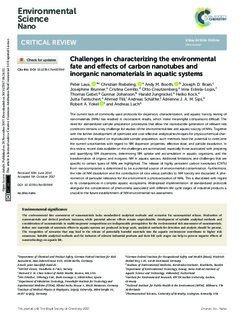Challenges in Characterizing the Environmental Fate and Effects of Carbon Nanotubes and Inorganic Nanomaterials in Aquatic Systems
| dc.contributor.author | Laux, Peter | |
| dc.contributor.author | Riebeling, Christian | |
| dc.contributor.author | Booth, Andy | |
| dc.contributor.author | Brain, Joseph | |
| dc.contributor.author | Brunner, Josephine | |
| dc.contributor.author | Cerrillo, Cristina | |
| dc.contributor.author | Creutzenberg, Otto | |
| dc.contributor.author | Estrela-Lopis, Irina | |
| dc.contributor.author | Gebel, Thomas | |
| dc.contributor.author | Johanson, Gunnar | |
| dc.contributor.author | Jungnickel, Harald | |
| dc.contributor.author | Kock, Heiko | |
| dc.contributor.author | Tentschert, Jutta | |
| dc.contributor.author | Tlili, Ahmed | |
| dc.contributor.author | Schäffer, Andreas | |
| dc.contributor.author | Sips, Adriënne | |
| dc.contributor.author | Yokel, Robert A. | |
| dc.contributor.author | Luch, Andreas | |
| dc.date.accessioned | 2017-12-04T07:49:35Z | |
| dc.date.available | 2017-12-04T07:49:35Z | |
| dc.date.created | 2017-10-05T11:30:41Z | |
| dc.date.issued | 2017 | |
| dc.identifier.issn | 2051-8153 | |
| dc.identifier.uri | http://hdl.handle.net/11250/2468859 | |
| dc.description.abstract | The current lack of commonly used protocols for dispersion, characterization, and aquatic toxicity testing of nanomaterials (NMs) has resulted in inconsistent results, which make meaningful comparisons difficult. The need for standardized sample preparation procedures that allow the reproducible generation of relevant test conditions remains a key challenge for studies of the environmental fate and aquatic toxicity of NMs. Together with the further development of optimized and cost-effective analytical techniques for physicochemical characterization that depend on reproducible sample preparation, such methods have the potential to overcome the current uncertainties with regard to NM dispersion properties, effective dose, and particle dissolution. In this review, recent data available on the challenges are summarized, especially those associated with preparing and quantifying NM dispersions, determining NM uptake and accumulation in aquatic organisms, and the transformation of organic and inorganic NM in aquatic species. Additional limitations and challenges that are specific to certain types of NMs are highlighted. The release of highly persistent carbon nanotubes (CNTs) from nanocomposites is determined to be a potential source of environmental contamination. Furthermore, the role of NM dissolution and the contribution of ions versus particles to NM toxicity are discussed. A phenomenon of particular relevance for the environment is photoactivation of NMs. This is elucidated with regard to its consequences in complex aquatic ecosystems. Widespread implementation of standardized protocols alongside the consideration of phenomena associated with different life cycle stages of industrial products is crucial to the future establishment of NM environmental risk assessment. | nb_NO |
| dc.language.iso | eng | nb_NO |
| dc.rights | Navngivelse-Ikkekommersiell-DelPåSammeVilkår 4.0 Internasjonal | * |
| dc.rights.uri | http://creativecommons.org/licenses/by-nc-sa/4.0/deed.no | * |
| dc.title | Challenges in Characterizing the Environmental Fate and Effects of Carbon Nanotubes and Inorganic Nanomaterials in Aquatic Systems | nb_NO |
| dc.type | Journal article | nb_NO |
| dc.description.version | publishedVersion | nb_NO |
| dc.rights.holder | The authors | |
| dc.source.journal | Environmental Science: Nano | nb_NO |
| dc.identifier.doi | 10.1039/C7EN00594F | |
| dc.identifier.cristin | 1502455 | |
| dc.relation.project | EU/237761 | nb_NO |
| dc.relation.project | Norges forskningsråd: 239199 | nb_NO |
| cristin.unitcode | 7566,6,0,0 | |
| cristin.unitname | Miljøteknologi | |
| cristin.ispublished | false | |
| cristin.fulltext | original |
Tilhørende fil(er)
Denne innførselen finnes i følgende samling(er)
-
Publikasjoner fra CRIStin - SINTEF Ocean [1312]
-
SINTEF Ocean [1384]

